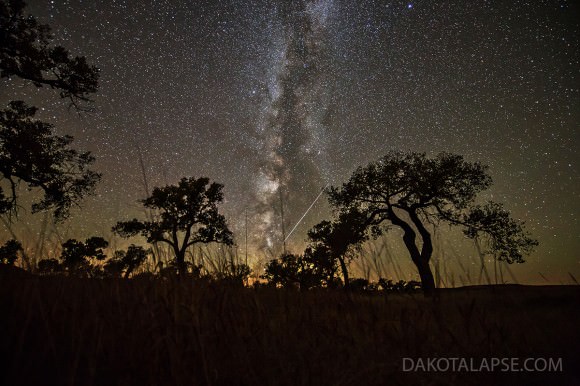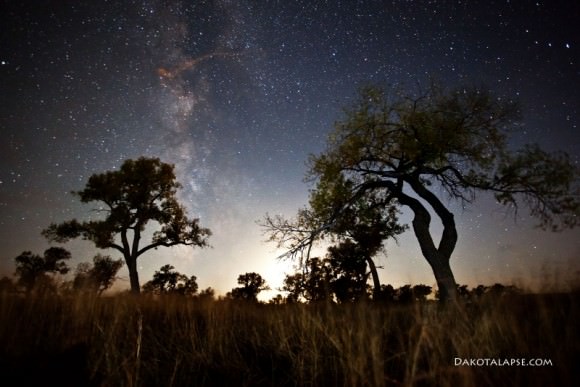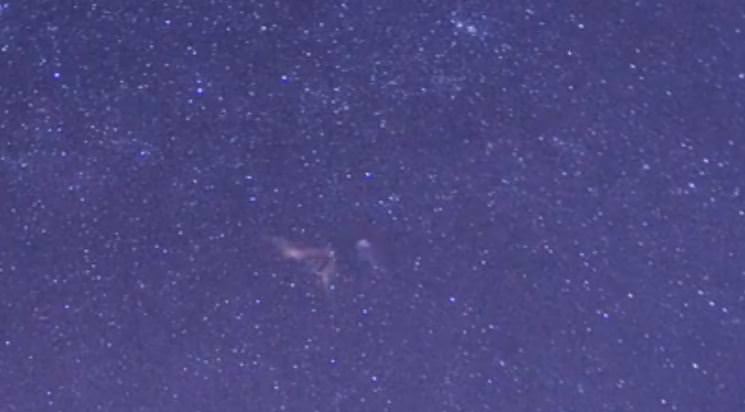Personally, I’ve never seen anything like this, and photographer and digital artist Michael K. Chung said he couldn’t believe what he saw when he was processing images he took for a timelapse of the Perseid meteor shower. It appears he captured a meteor explosion and the resulting expansion of a shock wave or debris ring.
“It was taken early in the morning on August 12, 2013 from my backyard in Victorville, CA,” Michael told Universe Today via email. “The fade to white is NOT an edit- it is overexposure due to the sun coming up. From what I can tell, the timelapse sequence of the explosion and expanding debris span an actual time of approximately 20 minutes.”
Michael said because he shoots at much higher resolution than 720p, he’s able to provide two different sequences in this video: one is with the full frame of each capture scaled/reduced and then cropped down to 1280×720, and the other is with the full frame kept at resolution with just the region around the explosion cropped to 1280×720. “I included each sequence twice – once at 24 frames per second and the other at around 12 fps.”
Amazing!
Since I’ve never seen anything like this, I decided to have one of our observing experts provide his opinion. UT writer David Dickinson said this is definitely legitimate.
“What cinches it for me is that the meteor was moving in the right direction for a Perseid,” Dave told me. “I see Perseus rising to the right, the plane of the Milky Way and Andromeda just above center.”
Dave said he has seen several meteors that leave lingering smoke trains. “I usually carry binoculars to examine these,” he said, “and saw several examples of this during the 1998 Leonid meteor storm from the desert in Kuwait, one of the most awesome things I’ve seen. Ever.”
Dave concurs, great catch by Michael Chung!
Update: Daniel Fischer provided a link to some imagery and information of the 1998 Leonid observations, showing persistent trains and more. Daniel also provided a more accurate description of what Michael Chung captured: “a persistent train after a Perseids fireball, being torn apart by upper atmosphere wind shear.”
Second update:
We heard from a few more people who also witnessed and captured similar Perseids with persistent trains.
Steve Knight from the UK also captured some explody-Perseids this year. Take a look at his video below, and at :15 and :19 there are fireballs followed by expanding cloud of debris — to see it better expand the video and look at the top right part of the screen. Andromeda Galaxy (M31) is visible drifting in from the left.
And Steve also provided animated gifs of the explosions:
Also, Randy Halverson from Dakotalapse, whose work we feature frequently on UT sent a couple of images of persistent trains from meteors, like this one:

…and this one of the cloud of debris left from a persistent train:

Watch his timelapse here, with the explosion taking place at about :53 into the film:
… with an interesting story that he set up his equipment to do a timelapse in the same place two years in a row and captured persistent trains both years. To find out more about that, as well as get more info on persistent trains, Phil Plait wrote this article about it.
There’s also an animated gif of an exploding Perseid from astromel on Flickr here.
2013 Perseids Meteor Shower: Meteor Explosion from Michael Chung on Vimeo.




Did anyone else witness the event?
Very likely, but I doubt it was captured on video at this resolution by anyone else. That is what makes this so special.
Very unique. Serendipity has its place!
I am so very thankful to have my video shared by Universe Today (this is Michael Chung). And, I learned something new through the process (about persistent trains). It was totally serendipitous that captured this sequence. I set up my timelapse and went to bed. And, the event was captured near the edge of my framing. In fact, while I was processing I had a decision to make about cropping. As I was unaware that that these frames were in the mix, it was only because of the visibility of the fireball that led me to decide to crop the image as it shows. Phew! I might have never known about these frames otherwise!
These “persistent trains” are now being captured increasingly commonly thanks to the
widespread availability of ultra-fast lenses and high sensitivity digital cameras.
I captured about 15 of them during last year’s Geminids. Here’s one particularly bright example:
http://itee.uq.edu.au/~davel/GeminidMeteorTrain.mp4
And as still frames (straight-out-of-camera on the left, stretched in the middle, stretched-and-inverted on the right):
http://itee.uq.edu.au/~davel/GeminidMeteorTrain.jpg
That is very cool!
X-Com +1
“Personally, I’ve never seen anything like this…” Really Nancy? Where were you on February 15th this year?! Fireballs/meteors/comet fragments are now exploding all over the place on a daily basis. Bookmark these pages: http://lunarmeteoritehunters.blogspot.com/, http://www.amsmeteors.org/ and http://www.sott.net/category/17-Fire-in-the-Sky
Short memories . . . we caught this nice head-on Leonid back in 1998:
http://apod.nasa.gov/apod/ap981123.html
Would you mind sharing the settings used to capture? Camera/lense/aperture/… the works?
Wow!! Next year, I’m going to take the day off so I can stay up and look for explody meteors. I missed it this year because I had to go to bed and get up for work. 🙁
Amazing. I actually caught a great perseid during last year’s show. It is definitely one of the best showers of the year. I love the fade from green to orange of the perseids!
I saw several persistent trails from the Perseids while on Wheeler Peak near the Utah/Nevada border this year. I was at about 7500 ft.
The best ones left a trail like a sparkling firework. Even more impressive was the way the brighter meteors would illuminate the landscape like a lightning bolt.